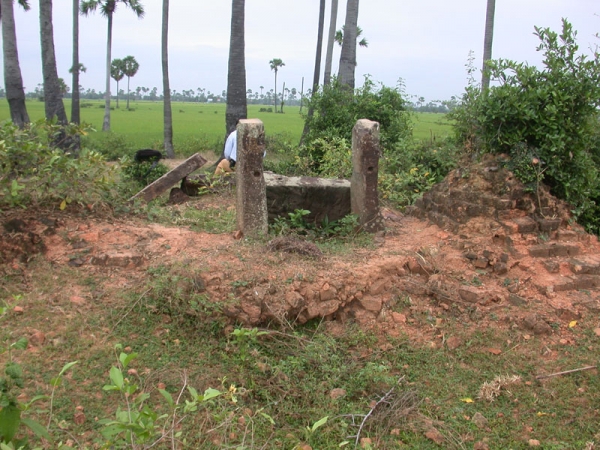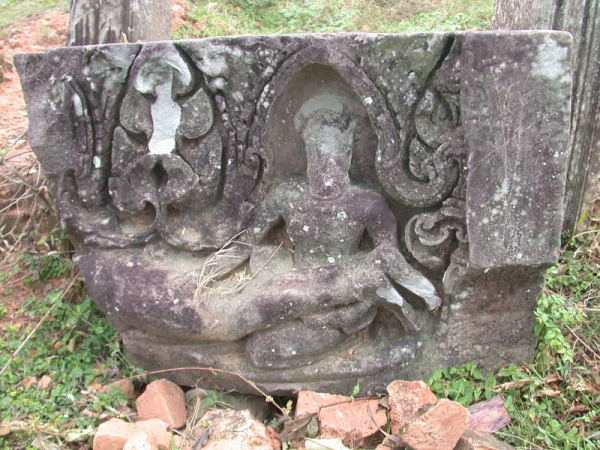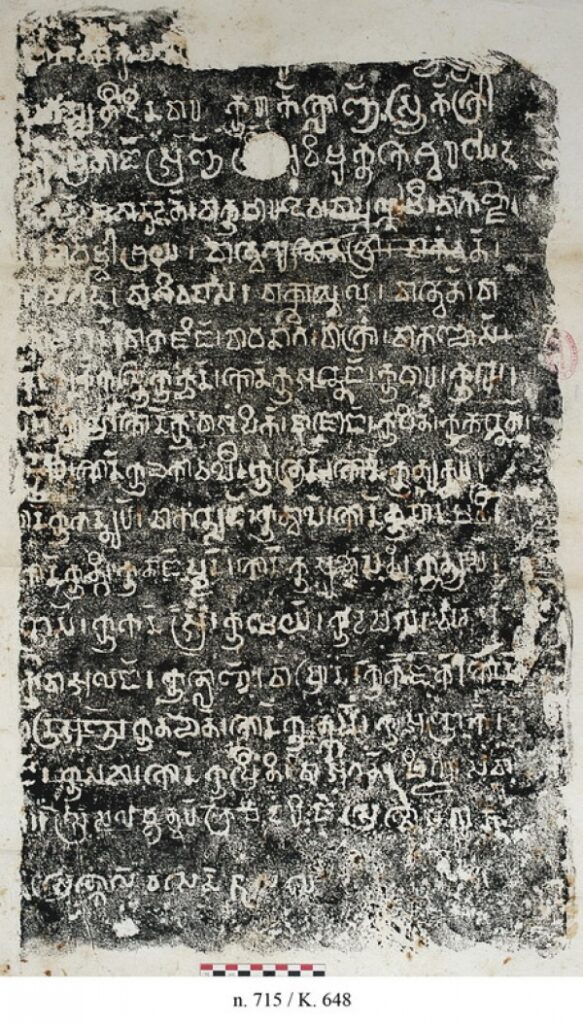អ្នកតាតាំងរាយ ជាទីទួលដែលមានសំណេះសំណល់សម្ភារៈសំណង់ប្រាសាទសម័យបុរាណ ស្ថិតនៅក្នុងភូមិសណ្ដែក ឃុំសណ្ដែក ស្រុកបាធាយ ខេត្តកំពង់ចាម។ ទីតាំងនេះ មានក្ដីបាក់បែកមួយរាងបួនជ្រុងស្មើ ធ្វើពីឥដ្ឋ និងមានឃើញគ្រឹះធ្វើពីថ្មបាយក្រៀម ព្រមទាំងស្លាកស្នាមមណ្ឌប(?)លយមកខាងមុខផង។ ក្ដីនេះ មានកសិន្ធុព័ទ្ធជុំវិញ មានច្រកចូលពីខាងកើតតាមស៊ុមទ្វារធ្វើពីថ្មភក់។
នៅទីនេះធ្លាប់រកឃើញផ្ដែរប្រាសាទ រចនាបថបាពួន មានចម្លាក់ព្រះនារាយណ៍ផ្ទំលើនាគអនន្ត ដែលអំឡុងឆ្នាំ២០០៧ ក្រុមការងារ CISARK ប្រទះឃើញនៅសល់តែពាក្យកណ្ដាលផ្នែកខាងស្ដាំប៉ុណ្ណោះ។ ស្ថាននាម «តាំងរាយ» នេះ បង្ហាញពីទំនាក់ទំនងរវាងឈ្មោះទីតាំងជាមួយនិងចម្លាក់ព្រះនារាយណ៍ផ្ទំនៅលើផ្ដែរនេះ។ ដ្បិតថាពាក្យ «តាំង» ច្រើនតែជាពាក្យហៅសំដៅដល់ទីទួល ដែលមានស្លាកស្នាមប្រាសាទបុរាណ នៅតាមតំបន់មួយចំនួនក្នុងប្រទេសកម្ពុជា។ ចំណែកឯពាក្យ «រាយ» នេះ ទំនងជាពាក្យកាត់ខ្លីចេញពីពាក្យ «នារាយណ៍» ដែលមានប្រភពមកសំស្ក្រឹត។ នៅទីនោះក៏មានបល្ល័ង្កថ្មភក់សម័យអង្គរស.វ.ទី១១ មួយ ដែលតាមលក្ខណៈរន្ធសម្រាប់បញ្ចុះ គឺប្រហែលជាជើងទម្រសម្រាប់តម្កល់ទេវរូប។ នៅឆ្នាំ១៩២៩ គេក៏បានរកឃើញសិលាចារឹកសម័យមុនអង្គរមួយផ្ទាំង ចារជាភាសាខ្មែរបុរាណ ចំនួន១៨បន្ទាត់។ ដូច្នេះទីតាំងនេះ ទំនងជាកសាងឡើងតាំងពីសម័យមុនអង្គរ និងជួសជុលឬសាងបន្ថែមនៅក្នុងស.វ.ទី១១ នាសម័យបាពួន។ បើពុំដូច្នោះ សិលាចារឹកសម័យមុនអង្គរមួយផ្ទាំងនេះ អាចរកឃើញនៅតំបន់ក្បែរនោះ និងយកមករក្សាទុកនៅទីតាំងនេះ។ បច្ចុប្បន្ន ផ្ទាំងសិលាចារឹកនេះ និងកំណាត់ផ្ដែរ ពុំស្ថិតនៅទីតាំងអ្នកតាតាំងរាយនេះទេ។

ទួលអ្នកតាតាំងរាយ (រូបថត៖ CISARK)

បំណែកផ្ដែរនៅទួលអ្នកតាតាំងរាយ (រូបថត៖ CISARK)
សិលាចារឹកនេះ មានចុះកាលបរិច្ឆេ ប៉ុន្ដែកាលបរិច្ឆេទនេះបានដាច់អស់ច្រើន អាចឱ្យដល់ត្រឹមតែស្ថិតនៅចន្លោះមហាសករាជឆ្នាំ៥០០ ឬចន្លោះរវាងចុងស.វ.ទី៦ដល់ពាក់កណ្ដាលស.វ.ទី៧ ដែលសមស្របតាមលក្ខណៈបុរាណលេខន៍ផងដែរ។ ចំពោះអត្ថន័យសង្ខេបនៃសិលាចារឹកនេះ គឺជាបញ្ជីតង្វាយអ្នកបម្រើប្រុសស្រី គោក្របី និងស្រែចម្ការ ចំពោះប្រាសាទព្រះគម្ដែងអញស្រីអវិមុក្តេសូរ ដែលជាប្រាសាទព្រះឥសូរ។ បើយោងតាមចម្លាក់ផ្ដែរព្រះវិស្ណុផ្ទំ ប្រាសាទនេះទំនងជាកែប្រែពីប្រាសាទព្រះឥសូរទៅជាប្រាសាទរបស់ព្រះនារាយណ៍វិញ នៅស.វ.ទី១១។
បើយោងតាមប្រព័ន្ធមណ្ឌល ការបង្ហាញពាក្យ «កុរាក៑ក្លោញ៑ស្រុក៑ក្រៅ» សំដៅដល់ កុរាកដែលជាមេស្រុកក្រៅ ទំនងជាបង្ហាញថាតំបន់រកឃើញសិលាចារឹកនិងតំបន់ជុំវិញនេះ គឺជាខេត្តក្រៅ មានមេកើយគ្រប់គ្រង និងមិនស្ថិតនៅដែនខាងក្នុង ដែលគ្រប់គ្រងដោយអំណាចកណ្ដាលដែលវ្យាធរបុរ ឬឦសានបុរ ផ្ទាល់។


(រូបថត៖ CISARK)
អត្ថបទដើមជាអក្សរខ្មែរទំនើប
១- [—]ញ្ចឝតឝកបរិគ្រហ——–វ្ឫ
២- [—]ហស្បតីទិនវារកុរាក៑ក្លោញ៑ស្រុក៑ក្រៅ
៣- [—]កម្រតាង៑អញ៑ឝ្រីអវិមុក្ដកេឝ្វរឃោទ
៤- [—]វាភានុទត៑១វាកុមារទេវ១វាបូណ៌្ណមី១វាកញ្ជា១
៥- [—]១វាធម៌្មាឝ្រយ១វាត្វេគុណិតវ្រៅ១វាកំវត៑១
៦- [—]១វាភទ១វាឝិវទាស១វាក្មាស្វេល៑១វាត្វេត៑១វា
៧- [—]វា(ចល)១វាកជិង៑១វាធនាគ១វាក្រោំ១វាកញ្ចេស៑១
៨- [—]១អ្នក៑កន្តៃកុក្ចន៑១កោន៑កុអន្តេង៑១កុធារ១កុឈេ១
៩- [—]១កុប្រេំ១កោន៑កុវាអបិក៑១វាងោង៑១កុបិត១កុកន្តេក៑១
១០- [—]១កោន៑កុឯកាវលី១កុត្រេន៑១កោន៑កុតុក្តរ៑១
១១- [—]កោន៑កុកន្តុរ៑១វាកន្សេង៑១កុត្វាល៑១កោន៑កុសានមតី១
១២- [—]កោន៑កុត្គី១កុតាង៑ប្ឱន៑១កោន៑កុសុខាបតី១កុត្យស៑១
១៣- [—]ន្រោស៑១កុកន៑អ១កុមេយ៑១កុឧបល១វាត្នះ១
១៤- [—]កុវាអលង៑១កុត្លោញ៑១វាប្រាន១កុកជក៑១កោន៑
១៥- [—]ន្រអញ៑១កុតឯត៑១កោន៑កុត្កប៑១កុអន្រោក៑១
១៦- [—]ង៑១កុសភា១កោន៑កុប្រីតិ១វាអគត៑១បិណ្ឌសវា
១៧- [—]៣ស្រេសរេ២០ត្មុរ៑ក្របិទំរិង៑ស្រេវៃសល៧
១៨- [—]ស្រេត្កោល៑វសេន៑៧សរេ
អត្ថបទប្រែសម្រួល មហាសករាជឆ្នាំ៥– [—] ថ្ងៃព្រហស្បតិ៍ កុរាកក្លោញស្រុកក្រៅ(ថ្វាយអ្នកបម្រើ)ចំពោះព្រះគម្ដែងអញស្រីអវិមុក្តកេសូរ។ អ្នកបម្រើប្រុស៖ វាភានុទត១ វាកុមារទេវ១ វាបូណ៌្ណមី១ វាកញ្ជា១ វាធម៌្មាស្រ័យ១ វាត្វេគុណិតវ្រៅ១ វាកំវត១ វាភទ១ វាឝិវទាស១ វាក្មាស្វេល១ វាត្វេត១ វាចល១ វាកជិង១ វាធនាគ១ វាក្រោម១ វាកញ្ចេស១។ អ្នកបម្រើស្រី៖ កុក្ចន១ កូនគឺកុអន្តេង១ កុធារ១ កុឈេ១ កុប្រេម១ កូនគឺកុវាអបិក១ វាងោង១ កុបិត១ កុកន្តេក១ [—]និងកូនគឺកុឯកាវលី១ កុត្រេន១ និងកូនគឺកុតុក្តរ១ [—]និងកូនគឺកុកន្តុរ១ វាកន្សេង១ កុត្វាល១ និងកូនគឺកុសានមតី១ [—]និងកូនគឺកុត្គី១ កុតាងប្អូន១ និងកូនគឺកុសុខាបតី១ កុត្យស១ [—]ន្រោស១ កុកន្អ១ កុមេយ១ កុឧបល១ វាត្នះ១ កុវាអលង១ កុត្លោញ១ វាប្រាន១ កុកជក១ និងកូនគឺ [—]ន្រអញ១ កុត្ឯត១ និងកូនគឺកុត្កប១ កុអន្រោក១ [—]ង១ កុសភា១ និងកូនគឺកុប្រីតិ១ វាអគត៑១។ សរុបទាំងក្មេងចាស់ប្រុសស្រី—។ —ស្រែ២០សន្រែ គោ ក្របី ច្បារដំណាំទ្រើង ស្រែវៃសល៧ [—]ស្រែត្កោលវសេន ៧ សន្រែ៕
———————–
Neak Ta Taing Reay Inscription K.648
Neak Ta Taing Reay, located in Sandaek Village, Sandaek Commune, Batheay District, and Kampong Cham province, consists of ruins that showcase a small brick shrine gracefully situated on a laterite base and surrounded by a moat. Through meticulous examination of the archaeological remnants, experts have uncovered various elements that provide insights into the original structure of the shrine. Remains of laterite blocks, brick courses, sandstone door jambs, and a pedestal offer glimpses into the architectural intricacies of this ancient site. The pedestal, in particular, suggests its potential function as a platform for a statue, further enhancing the shrine’s significance.
The name “Neak Ta Taing Reay” holds cultural significance and is widely recognized within the Khmer community of the region. In Cambodian Animism, the term “Neak Ta” is used to refer to ancestral or guardian spirits. “Taing” is a Khmer word that denotes a small mount often associated with temple ruins found in various parts of Cambodia. The term “Reay” is believed to originate from the Khmer term “Noreay,” which is a popular name for Vishnu and has its roots in the Sanskrit word “Nārāyaṇa.”
Among the notable discoveries at Neak Ta Taing Reay is a remarkable Baphuon style lintel depicting a reclining Vishnu. Initially, the lintel was found intact, but during a survey conducted by the CISARK team around 2007, only half of it was uncovered. Regrettably, the remaining half of the lintel and the inscription identified as K.648 in the inventory are currently not present at the site. Their current whereabouts and accessibility remain unknown. Nevertheless, the discovery of the partial lintel has provided valuable insights into the artistic and cultural significance of the site during that period.
In addition, the inscription K.648 is written in the Pre-Angkorian Pallava script using the Old Khmer language. There is a date mentioned in the text, but unfortunately, the date is partially illegible. The existing date corresponds to the Śaka year 500, which indicates a timeframe ranging from the late 6th to the mid-7th century. This date has been confirmed through palaeography. This concise inscription documents the offerings made to Śrī Avimuktakeśvara by the kurāk, who is the headman of a specific outsider of the domain or community (Sruk Krau). The offerings mentioned in the inscription include slaves, Iceland, cattle, and a plantation.
Based on the Mandala system, the area mentioned as an outsider of the domain or community is likely not directly under the control of the central power at Vyadhapura or Ishanapura. This suggests that Neak Ta Taing Reay and its surrounding region may have had a semi-autonomous status or operated within a decentralized governance structure during that period.
Śrī Avimuktakeśvara is indeed an epithet of Śiva, signifying a form or aspect of Lord Śiva. Considering that the lintel discovered at Neak Ta Taing Reay depicts a reclining Vishnu, it suggests the possibility of a transformation or repurposing of the temple from a Saivism temple (dedicated to Śiva) to a Vaishnava temple (dedicated to Vishnu). Such transitions or adaptations of religious affiliations have been observed in various historical sites and can indicate shifts in religious practices or patronage over time.
អត្ថបទដោយ៖ លោក ហ៊ុន ឈុនតេង






